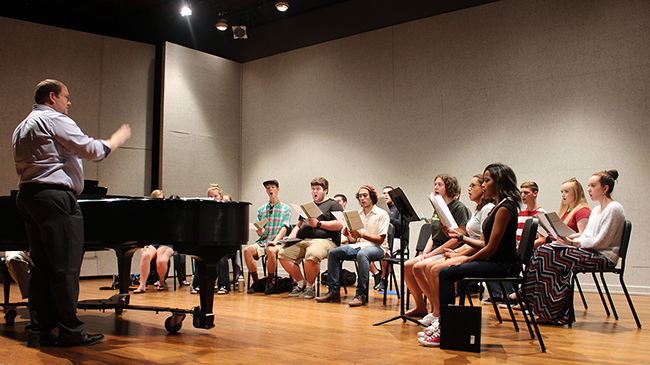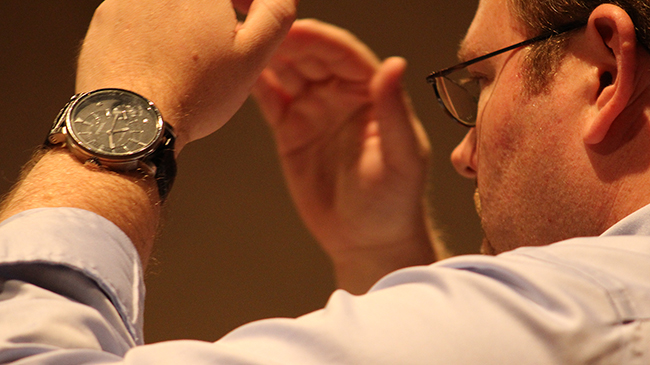By Steven Krolak
(NEW ALBANY, Ind.)—Close your eyes and listen to a piece of choral music.
As a listener, you revel in pure sound.
But for the performers, all that pristine audio is the product of a lot of visual training that starts with sight-singing, what you might call “reading music cold.”
The ways and benefits of this skill are the subject of “Sight Singing: What Is It Good For—Absolutely Everything!”, an article by Jeramy Nichols, assistant professor of music education and choral music, in the latest issue of Ala Breve, the journal of the Alabama Music Educators Association.
A high-wire act
“Choral sight-singing is the action of singing a melody or piece of music at sight without instrumental accompaniment,” Nichols writes.
For a singer of any level it can be a high-wire act, especially when it forms a compulsory element of an audition or competition.
But as Nichols writes, it’s a foundational skill that benefits singers in ways that transcend the ability to carry a tune.
Mastering ascending and descending intervals, rhythmic patterns, melodic phrasing and dynamics are some of the benefits to overall musical skills conveyed by a grounding in sight-singing.
“You’re really doing three things at once,” Nichols said. “You’re listening for pitch, matching pitch and singing rhythm.”

Jeramy Nichols leads a reading with the IU Southeast Concert Choir.
And sight-singing is a skill that reinforces itself.
“Sight-singing gives choral ensembles the opportunity to sing through choral selections with more musical independence,” Nichols writes. “As the choral ensemble becomes more musically independent, choirs develop more confidence when sight-singing.”
Do-re-mi and beyond
In his article, Nichols explores the major techniques used to help students sight-sing.
Solfege will be familiar to anyone who has seen “The Sound of Music.” It’s the “do-re-mi” method of assigning syllables to the eight pitches of an octave.
Everyone can recite the scale, but it takes sight-singing practice to link the syllables to the notes well well enough to apply them to any melody.
A system of gestures known as the Curwen hand signs, named for the 19th century English minister and educator John Curwen, allow the conductor to indicate both specific notes and octaves.
This kinesthetic element has more benefits than just orientation.
“By using kinesthetic and visual models when learning pitch patterns, scale degrees, intervals, etc., students have the opportunity to reinforce their auditory skills,” Nichols writes.

Sight-singing is aided by the Curwen hand-signals.
Nichols notices that students arriving at IU Southeast bring varying skill levels and instructional experiences with them. They range from singers who have been trained in solfege from day one at larger high schools with established choral programs to those who have learned to sing by rote memorization of music played for them on an instrument, to students who have always wanted to sing but have had little or no formal training.
No matter their choral origins, once at IU Southeast, they are introduced to a more rigorous and systematic combination of solfege and Curwen signs, the lingua franca of choral training that will strengthen their skills as choristers and musicians.
Building musicianship
Moving beyond technique, Nichols makes the case that music programs should commit more fervently to sight-singing instruction.
This comes at a time when it seems that choral competitions have become as important as, and in some cases more important than, long-term student success for many programs, according to Nichols.
In many cases, awards and citations become akin to an assessment that pedagogical goals are being met.
Choirs are judged in part on their ability to sight-sing, but only up to a point, and not in a way that truly measures musicianship.
“It appears sometimes that it’s all about the plaque on the wall,” Nichols said.
By focusing on sight-singing as a way to build well-rounded musicians instead of merely good testing students, music programs can reap more significant rewards in the form of performance standards that challenge students and deepen the musical life of the institution.
Nichols’ approach is evident in his attention to the choral program at IU Southeast, where he incorporates sight-singing into ensemble rehearsals, to teach listening skills, independent singing and tuning.
IU Southeast has two ensembles that welcome students who want to sing. The Concert Choir is made up of students. Most are music majors, but there are students from other majors as well. Most of these come from high school programs with strong foundations, but that’s not a requirement, Nichols said.
“Those students whose foundation is not as strong will catch up quickly in the company of more advanced singers,” Nichols said.
The Community Chorus consists of community members and students. The students may or may not have experience, but all profit from the help of community members with more years of singing under their belts.
With this interplay of skill levels and a dedication to solid sight-singing fundamentals, Nichols is shaping the choral program to address the full range of a singer’s creative needs.
“We want to instill and equip our choral singers with independent musicianship skills in hopes of developing musical literacy,” Nichols writes.


